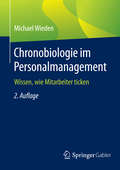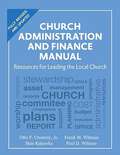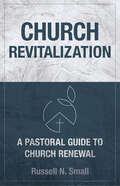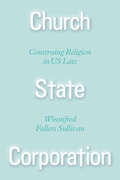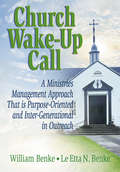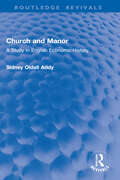- Table View
- List View
Chronobiologie im Personalmanagement: Wissen, wie Mitarbeiter ticken
by Michael WiedenDieses Fachbuch zeigt Wege auf, wie innovative Führungsansätze zu neuer Produktivität und einer Win-win-Situation für alle Beteiligten führen können. Gegenüber der ersten Auflage wird in dieser zweiten, inhaltlich erweiterten Auflage das große Potenzial, das in der Nutzung der Erkenntnisse aus der Chronobiologie liegt, intensiver beleuchtet. Michael Wieden erläutert, wie sich mit dem Wissen um das Ticken der genetisch bedingten inneren Uhr das Wesen des Arbeitens, dessen Wert, aber auch das Verständnis von Lebensqualität in den kommenden Jahrzehnten nachhaltig verändern werden und alle Prozessbeteiligten davon profitieren können.
Chronologies of Modern Terrorism
by Barry Rubin Judith Colp RubinConcise yet comprehensive, this one-volume reference examines the history of terrorism in the modern world, including its origins and development, and terrorist acts by groups and individuals from the French Revolution to today. Organized thematically and regionally, it outlines major developments in conflicts that involved terrorism, the history of terrorist groups, key aspects of counterterrorist policy, and specific terrorist incidents.Initial chapters explore terrorism as a social force, and analyze the use of terrorism as a political tool, both historically and in the contemporary world. Subsequent chapters focus on different parts of the world and consider terrorism as a part of larger disputes. Each chapter begins with a historical introduction and analysis of the topic or region, followed by one or more chronologies that trace events within political and social contexts. A glossary, selected bibliography, and detailed index are also included.
Chronology of Venezuelan Oil (Routledge Library Editions: The Oil Industry #2)
by Anibal R. MartinezChronology of Venezuelan Oil (1969) covers all aspects of the Venezuelan petroleum industry’s historical evolution: technical, legal, economic, social and political to create a reference source for scholars, teachers, executives, professionals and technicians, as well as students of the industry.
Chronology of the Asian Financial Crisis
by Laura Alfaro Rafael Di Tella Renee KimIn July 1997, Thailand became the first Asian "tiger" economy to abandon its fixed exchange rate system in response to speculative attacks on its currency. Investors started to flee Asia, and the crisis rapidly spread to other countries. Central banks spent billions of dollars to try and defend their currencies, only to seek emergency bailouts from the International Monetary Fund. This case presents a chronology of events that unraveled during the Asian financial crisis from 1997 to the end of 1998.
Chrysanthemum and Dragon: JAFCO Asia in China
by David Lane Rawi AbdelalIn the autumn of 2002, JAFCO Asia, a subsidiary of JAFCO Co., Ltd., became the first foreign private equity firm to open an office in Beijing's Haidian Science Park. JAFCO was the only Japanese private equity firm operating in China. As such, Managing Director Vincent Chan observed, "JAFCO is the bridge between Japan and China." Yet, under that bridge the waters appeared increasingly choppy. While the economic relationship between Japan and China had grown increasingly close, their political relations had not and some Japanese firms had begun to reassess their commitment to China. Would capital-rich Japan and capital-poor China find a way to transcend their troubled history? Could JAFCO Asia be a catalyst for cooperation, or would its managers find their own operations affected by rivalry between Asia's two most important countries? The mix of formal rules and informal practices that governed foreign private equity firms in China was complex. Opening an office in Beijing signified a renewal of JAFCO Asia's efforts to master these challenges and coincided with an acceleration of the firm's investments. But JAFCO's first years of engagement with China had not been notably successful, and without some fundamental changes, there was little reason to believe that the addition of a physical presence there would yield better results now.
Chrysler Fiat 2009
by David Lane Paul W. Marshall J. Bruce HarreldIn spring 2009, Chrysler entered a prepackaged bankruptcy and exited 40 days later in a deal with Fiat, the U.S. Treasury, and the UAW that kept the automaker alive. Looking forward, what was necessary for Chrysler to move beyond the life support it had received? What was possible? Looking back, how should the company's restructuring be assessed?
Chrysler Takeover Attempt
by Richard S. Ruback William DewittOn April 12, 1995, Kirk Kerkorian made an unsolicited offer to buy the outstanding shares of Chrysler Corp. This case analyzes the proposed deal and addresses the key contextual elements contributing to the takeover attempt.
Chrysler and BMW: Tritec Engine Joint Venture
by H. Kent Bowen Courtney PurringtonA gifted project leader lacks significant new product development experience. The case highlights the issues and procedures related to defining the project strategy: organizing senior management approvals and support for creating a "heavyweight" team; aligning the disparate perspectives, interests, and biases of project members; and implementing best-practice tools for managing teams within the project. Creates a framework for establishing organizational design rules and key new product development processes, and also provides insights about models of leadership for new product development.
Chrysler's Sale to Fiat
by Lena G. Goldberg C. Fritz Foley Linnea MeyerThis case provides students with an opportunity to analyze the restructuring of Chrysler in the midst of the financial crisis of 2008-2009. It describes how debtors can use section 363 of the U.S. Bankruptcy Code to sell assets quickly. It allows for discussion of who benefits and who loses in such restructurings, and it also raises a variety of policy issues concerning 363 sales and the appropriate role of government entities in restructurings.
Chrysler: Iacocca's Legacy
by Nitin Nohria Sandy E. GreenDescribes the changes fashioned by Iacocca during his tenure as CEO of the Chrysler Corp. Pays particular attention to the rhetoric he employed in mobilizing change and the actions he took to implement change.
Chuck's Wagon Inc.
by Paul W. Marshall Derek LewisThis case describes the experiences of an HBS student as he takes on the challege of transitioning from an intern to a president at a small consumer packaged goods firm in Southern Texas. This HBS student is confronted with the opportunity to perform an operational and financial turnaround at the company within one year. Over his short tenure, he is forced to deal with several critical immediate issues that include product line shutdowns, immediate measurement systems, and executive team building.
Chucks!: The Phenomenon of Converse: Chuck Taylor All Stars
by Hal PetersonIn this book, shoe enthusiast Hal Peterson takes an in-depth look at the history, significance, and magic of "Chucks.” Originally a rubber shoe company, Converse rolled out the canvas All Star in 1917, nicknamed ?Chucks” for the basketball hall-of-famer, Charles "Chuck” Taylor, who was a lifelong promoter. The shoe quickly became a phenomenon that has lasted for nearly a century with a fanbase that has varied greatly. Though they have a simple, classic style, the many shoes photographed here make clear that true believers always find ways to individualize their favorite footwear, even though black was the only color available for almost fifty years. Peterson explores trends in everything from lace styles to color schemes and highlights Converse’s feature that allows you to "design your own.” He also takes a look at the social importance of Chucks: appearing in sports, rock and roll, movies, and art, they are known as one of the most iconic examples of twentieth-century footwear design. What is it about this sneaker that makes it so culturally pervasive? With help from Converse-wearers, we’ll find the answers.
Chudley and Greeno's Building Construction Handbook
by Roy Chudley Roger Greeno Karl KovacThe 13th edition of Chudley and Greeno’s Building Construction Handbook remains THE authoritative reference for all construction students and professionals. The principles and processes of construction are explained with the concepts of design included where appropriate. Extensive coverage of building construction practice, techniques and regulations representing both traditional procedures and modern developments are included to provide the most comprehensive and easy-to-understand guide to building construction.This new edition has been updated to reflect recent changes to the Building Regulations, as well as including new material on modern methods of construction, greater emphasis on sustainability, health and safety, and coverage of heat pumps, photovoltaics, underfloor heating and rainwater harvesting.Chudley and Greeno’s Building Construction Handbook is the essential, easy-to-use resource for undergraduate and vocational students on a wide range of courses including NVQ and BTEC National, through to Higher National Certificate and Diploma, to Foundation and three-year degree level. It is also a useful practical reference for building designers, contractors and others engaged in the construction industry.
Chung and Dasgupta: Information for Casey Clark
by Ian I. Larkin Karen HuangThe "Promotion Process at Chung and Dasgupta, LLP" set of cases explores the roles of general and firm-specific human capital in employee performance measurement, feedback, and promotion/compensation decisions. In the cases, a leading law firm must decide whether to match an outside partnership offer to one of its leading litigators, when the litigator is not yet eligible for partnership according to the existing rules by which the firm elects partners. A second non-litigator at the firm has performed just as well as the star litigator, but has no outside partnership offer, because her role and skills are specific to the firm, and not as valuable to the outside market. The case can be taught via a role play, where one student plays the role of the non-litigator, and a second student plays the role of a formally-assigned mentor from the law firm's partnership group. (If using the role play option, instructors should use the general information case "The Promotion Process at Chung and Dasgupta, LLP," 914-044, and the roles: "Chung and Dasgupta: Information for Jordan Ramirez," 914-046, and "Chung and Dasgupta: Information for Casey Clark," 914-047.) It can also be taught as a traditional case, without a role play, by using general information case "The Promotion Process at Chung and Dasgupta, LLP" (914-044) and "Chung and Dasgupta: Supplemental Information on Jordan Ramirez and Casey Clark" (914-045). The cases provide a rich backdrop to explore issues around firm-specific human capital, and can also be used to discuss subjective performance evaluation, best practices when giving employee feedback, and careers at professional service firms.
Chung and Dasgupta: Information for Jordan Ramirez
by Ian I. Larkin Karen HuangThe "Promotion Process at Chung and Dasgupta, LLP" set of cases explores the roles of general and firm-specific human capital in employee performance measurement, feedback, and promotion/compensation decisions. In the cases, a leading law firm must decide whether to match an outside partnership offer to one of its leading litigators, when the litigator is not yet eligible for partnership according to the existing rules by which the firm elects partners. A second non-litigator at the firm has performed just as well as the star litigator, but has no outside partnership offer, because her role and skills are specific to the firm, and not as valuable to the outside market. The case can be taught via a role play, where one student plays the role of the non-litigator, and a second student plays the role of a formally-assigned mentor from the law firm's partnership group. (If using the role play option, instructors should use the general information case "The Promotion Process at Chung and Dasgupta, LLP," 914-044, and the roles: "Chung and Dasgupta: Information for Jordan Ramirez," 914-046, and "Chung and Dasgupta: Information for Casey Clark," 914-047.) It can also be taught as a traditional case, without a role play, by using general information case "The Promotion Process at Chung and Dasgupta, LLP" (914-044) and "Chung and Dasgupta: Supplemental Information on Jordan Ramirez and Casey Clark" (914-045). The cases provide a rich backdrop to explore issues around firm-specific human capital, and can also be used to discuss subjective performance evaluation, best practices when giving employee feedback, and careers at professional service firms.
Chung and Dasgupta: Information for Jordan Ramirez
by Ian I. Larkin Karen HuangThe "Promotion Process at Chung and Dasgupta, LLP" set of cases explores the roles of general and firm-specific human capital in employee performance measurement, feedback, and promotion/compensation decisions. In the cases, a leading law firm must decide whether to match an outside partnership offer to one of its leading litigators, when the litigator is not yet eligible for partnership according to the existing rules by which the firm elects partners. A second non-litigator at the firm has performed just as well as the star litigator, but has no outside partnership offer, because her role and skills are specific to the firm, and not as valuable to the outside market. The case can be taught via a role play, where one student plays the role of the non-litigator, and a second student plays the role of a formally-assigned mentor from the law firm's partnership group. (If using the role play option, instructors should use the general information case "The Promotion Process at Chung and Dasgupta, LLP," 914-044, and the roles: "Chung and Dasgupta: Information for Jordan Ramirez," 914-046, and "Chung and Dasgupta: Information for Casey Clark," 914-047.) It can also be taught as a traditional case, without a role play, by using general information case "The Promotion Process at Chung and Dasgupta, LLP" (914-044) and "Chung and Dasgupta: Supplemental Information on Jordan Ramirez and Casey Clark" (914-045). The cases provide a rich backdrop to explore issues around firm-specific human capital, and can also be used to discuss subjective performance evaluation, best practices when giving employee feedback, and careers at professional service firms.
Chung and Dasgupta: Supplemental Information on Jordan Ramirez and Casey Clark
by Ian I. Larkin Karen HuangThe "Promotion Process at Chung and Dasgupta, LLP" set of cases explores the roles of general and firm-specific human capital in employee performance measurement, feedback, and promotion/compensation decisions. In the cases, a leading law firm must decide whether to match an outside partnership offer to one of its leading litigators, when the litigator is not yet eligible for partnership according to the existing rules by which the firm elects partners. A second non-litigator at the firm has performed just as well as the star litigator, but has no outside partnership offer, because her role and skills are specific to the firm, and not as valuable to the outside market. The case can be taught via a role play, where one student plays the role of the non-litigator, and a second student plays the role of a formally-assigned mentor from the law firm's partnership group. (If using the role play option, instructors should use the general information case "The Promotion Process at Chung and Dasgupta, LLP," 914-044, and the roles: "Chung and Dasgupta: Information for Jordan Ramirez," 914-046, and "Chung and Dasgupta: Information for Casey Clark," 914-047.) It can also be taught as a traditional case, without a role play, by using general information case "The Promotion Process at Chung and Dasgupta, LLP" (914-044) and "Chung and Dasgupta: Supplemental Information on Jordan Ramirez and Casey Clark" (914-045). The cases provide a rich backdrop to explore issues around firm-specific human capital, and can also be used to discuss subjective performance evaluation, best practices when giving employee feedback, and careers at professional service firms.
Chung and Dasgupta: Supplemental Information on Jordan Ramirez and Casey Clark
by Ian I. Larkin Karen HuangThe "Promotion Process at Chung and Dasgupta, LLP" set of cases explores the roles of general and firm-specific human capital in employee performance measurement, feedback, and promotion/compensation decisions. In the cases, a leading law firm must decide whether to match an outside partnership offer to one of its leading litigators, when the litigator is not yet eligible for partnership according to the existing rules by which the firm elects partners. A second non-litigator at the firm has performed just as well as the star litigator, but has no outside partnership offer, because her role and skills are specific to the firm, and not as valuable to the outside market. The case can be taught via a role play, where one student plays the role of the non-litigator, and a second student plays the role of a formally-assigned mentor from the law firm's partnership group. (If using the role play option, instructors should use the general information case "The Promotion Process at Chung and Dasgupta, LLP," 914-044, and the roles: "Chung and Dasgupta: Information for Jordan Ramirez," 914-046, and "Chung and Dasgupta: Information for Casey Clark," 914-047.) It can also be taught as a traditional case, without a role play, by using general information case "The Promotion Process at Chung and Dasgupta, LLP" (914-044) and "Chung and Dasgupta: Supplemental Information on Jordan Ramirez and Casey Clark" (914-045). The cases provide a rich backdrop to explore issues around firm-specific human capital, and can also be used to discuss subjective performance evaluation, best practices when giving employee feedback, and careers at professional service firms.
Church Administration and Finance Manual (Fully Revised and Updated): Resources for Leading the Local Church
by Otto F. Crumroy Jr. Stan Kukawka Frank M. Witman Paul D. WitmanA field-tested guide to the management and finance of church congregations, revised for a new generation. <p><p> Clergy are generally equipped to preach and provide spiritual care. But when it comes to budgets, insurance, fire safety, and church management many find themselves at a loss. The Church Administration and Finance Manual is the classic guide to running a church, written to answer key questions for clergy and lay leaders. <p><p> Not simply a theoretical resource, the Manual provides suggestions for almost every aspect of parish administration: position descriptions, financial forms, materials for stewardship and Christian education, building use and safety issues, employee record keeping, and much more. This revised edition offers guidance on many new topics that are of vital importance to churches, including protecting children, information security, approaches to preventing and responding to violence, planned giving, social media, and hybrid work and worship. <p><p> Whether clergy are just out of seminary or well-seasoned in parish life, the Manual is full of excellent guidelines, tools, and forms for improving the management of the parish.
Church Revitalization: A Pastoral Guide to Church Renewal
by Russell N. SmallChurch Revitalization guides current and future leaders through the often-complex process of bringing a church to a place of vibrancy. This book demonstrates how the overarching goal of seeing people come to faith in Christ and develop into Christlikeness can—and must—inform the most foundational to the most fleeting aspects of revitalizing a struggling church. Church Revitalization Strategist Rusty Small systematically walks readers through the many considerations of leading a church out of a decline. He helps identify the best approach for addressing what a particular church’s revitalization need may be: Refresh – often most fitting after a difficult season in the church’s life Renovate – needed when a decline has lasted five to ten years Restore – appropriate for churches with generational patterns focused on survival Replant – best for a church facing imminent closure Few joys compare to seeing God’s life and power realized for the local church—when believers begin to think and serve as Jesus did. Small will encourage pastors and church leaders engaged in this critical task. If God is calling you to church revitalization, take and read!
Church State Corporation: Construing Religion in US Law
by Winnifred Fallers SullivanChurch and state: a simple phrase that reflects one of the most famous and fraught relationships in the history of the United States. But what exactly is “the church,” and how is it understood in US law today? In Church State Corporation, religion and law scholar Winnifred Fallers Sullivan uncovers the deeply ambiguous and often unacknowledged ways in which Christian theology remains alive and at work in the American legal imagination. Through readings of the opinions of the US Supreme Court and other legal texts, Sullivan shows how “the church” as a religious collective is granted special privilege in US law. In-depth analyses of Hosanna-Tabor v. EEOC and Burwell v. Hobby Lobby reveal that the law tends to honor the religious rights of the group—whether in the form of a church, as in Hosanna-Tabor, or in corporate form, as in Hobby Lobby—over the rights of the individual, offering corporate religious entities an autonomy denied to their respective members. In discussing the various communities that construct the “church-shaped space” in American law, Sullivan also delves into disputes over church property, the legal exploitation of the black church in the criminal justice system, and the recent case of Masterpiece Cakeshop v. Colorado Civil Rights Commission. Brimming with insight, Church State Corporation provocatively challenges our most basic beliefs about the ties between religion and law in ostensibly secular democracies.
Church Wake-Up Call: A Ministries Management Approach That is Purpose-Oriented and Inter-Generational in Outreach
by David L Loudon Robert E Stevens William Benke Le Etta BenkeIs your church viable in the changing marketplace of today--and tomorrow?Today's church market is comprised of four cultural paradigms--Youth, Baby Busters (Generation X), Baby Boomers, and Pre-Boomers. Each has unique characteristics in terms of attitudes, spiritual orientation, values, emotional needs, moral perspective, and lifestyle. This implies significant changes for the church--new approaches to ministry and different methods of communication and interface. Church Wake-Up Call's unique “Ministries Matrix” approach provides effective management techniques to help you define and evaluate duties, priorities, and remedial actions for the future of your ministry in today's multigenerational context.Church Wake-Up Call will inform and enlighten you on these subjects: understanding and using the Ministries Matrix to define purposes and priorities for your church eirecting your ministry toward a particular age group without compromising the church's message increasing your church's visibility structuring your church's management organization creating an effective outreach program . . . and more!Although the book is oriented toward churches and their leadership and has been written largely from an evangelical Christian perspective, the descriptive information regarding each of the generational categories that comprise today's populace is applicable to all Christian organizations, whether they be evangelical or mainline Protestant, Catholic or parachurch. Similarly, the management system, which integrates defined purposes, priorities, and programming options into a well-coordinated plan of action, can be applied by all such organizations.
Church and Estate: Religion and Wealth in Industrial-Era Philadelphia
by Thomas F. RzeznikIn Church and Estate, Thomas Rzeznik examines the lives and religious commitments of the Philadelphia elite during the period of industrial prosperity that extended from the late nineteenth century through the 1920s. The book demonstrates how their religious beliefs informed their actions and shaped their class identity, while simultaneously revealing the ways in which financial influences shaped the character of American religious life. In tracing those connections, it shows how religion and wealth shared a fruitful, yet ultimately tenuous, relationship.
Church and Estate: Religion and Wealth in Industrial-Era Philadelphia
by Thomas F. RzeznikIn Church and Estate, Thomas Rzeznik examines the lives and religious commitments of the Philadelphia elite during the period of industrial prosperity that extended from the late nineteenth century through the 1920s. The book demonstrates how their religious beliefs informed their actions and shaped their class identity, while simultaneously revealing the ways in which financial influences shaped the character of American religious life. In tracing those connections, it shows how religion and wealth shared a fruitful, yet ultimately tenuous, relationship.
Church and Manor: A Study in English Economic History (Routledge Revivals)
by Sidney Oldall AddyChurch and Manor (1913) examines the unit of English territorial organisation known as the manor. It considers the manor and the church to be key twin parts of this unit, as the church was not only the place of worship but also often the seat of local government. By analysing the church and manor, this book provides valuable insight into the economic history of England, looking at the local focus of economic activity.
